An Analysis on Hydraulic Loss in a Co-Rotating Bladed Disc Pump
Abstract
1. Introduction
- The initial Tesla disc pump only utilizes the viscous force, the internal flow field, and performance analyses presented by Hasinger and Kehrt [11]. Murata et al. [12,13] and Roddy et al. [14] showed that its performance is generally worse than that of a common centrifugal pump, but that the internal flow field is more stable and the streamline between discs almost axisymmetric. Wang et al. [15] analyzed the loss mechanism in the Tesla disc pump and found that the main losses occur downstream of the impeller. Cheremushkin and Polyakov [16] optimized the volute of a Tesla disc pump model, and the optimized model achieved better efficiency compared to the original model.
- In contrast, the TBD pump not only utilizes not the viscous force but also the blade-like structure; moreover, the spacing between discs is much wider, similar to a common centrifugal pump. The pure radial blade shape can be considered to be quite crude in terms of design, especially for something used in impeller inlet conditions, compared to other designs, but this choice has been made to make disc pump more robust according to the transported mixture to be worked with. Therefore, the internal flow field and operating mechanism of the TBD pump are much more complex. The research team at the China University of Petroleum (East China) presented several studies related to TBD pumps that were applied in marine petroleum engineering and used as the mud-lifting pump, and these studies mainly focused on the influence of the geometrical parameters on pump performance [17,18,19], and the presented studies also showed evidence of the anti-wearability of TBD pumps by finding that the solid particles mainly concentrated in the bladeless area, which greatly reduced the interaction between the impeller and the solid particles [19,20,21,22]. Pei et al. [23] presented an approach to estimate the velocity slip at the impeller outlet, which could be helpful for t disc pump performance predictions, but only in situations that are close to design conditions. These studies provided interesting contributions for understanding the overall characteristics of TBD pumps. However, all of the published works that have been found in the available literature on TBD pumps only present overall performances and, more precisely, global efficiency, no information on the hydraulic efficiency of such pumps can be found, and there is also a research gap in terms of the evaluation of the loss distribution in each component of such a specific pump design.
2. Presentation of the Present TBD Pump Geometry
3. Overall Pump Performances
3.1. Experimental Test Bench and Instruments
3.2. Experimental Results
3.3. Numerical Simulation Set-Up and Results
4. Pump Component Performances and Related Losses
4.1. Impeller Total Head Coefficient ψt,t,2 versus Flow Coefficient φ
- (1)
- These two-limiting couple of values allow us to check if the coherence of these results using the so-called rotary pressure, which can be derived from the energy conservation in the relative frame of reference and can be written as follows (Gülich [25]):along a mean streamline for an ideal transformation. For a real transformation, it can be written as (Gülich [25]):P1 + 0.5ρ(W12 − U12) = P2,id + 0.5ρ(W22 − U22)or:P1/ρg + (W12 − U12)/2g = P2/ρg + (W22 − U22)/2g + head lossesSo,P2/ρg − P1/ρg= (U22 − U12)/2g − (W22 − W12)/2g − head losseshead losses = (U22 − U12)/2g − (W22 − W12)/2g − (P2 − P1)/ρg = 31 m
- (2)
- For φ = 0.1183, the difference between ψ*t,t,2 and ψ*t,s,2 can be written asψ*t,t,2 − ψ*t,s,2 = (Pt,2 − Pt,1) imp/ρU22 − (Ps,2 − Pt1)imp/ρU22 = Vθ22/2U22 + Vr22/2U22
- (3)
- For φ = 0, the difference between the total and static head at the impeller outlet can be written as (Gülich [25]):and for φ = 0, Vr2 = 0, and V2 = Vθ2H2 − h2 = V22/2gwhere μ is the slip factor, which is equal to Vθ2/U2, meaning that one can obtainV22/2g = μ2U22/2gg(H2 − h2)/U22 = 0.5
4.2. Impeller Internal Flow Loss Evaluation
5. One-Dimensional Loss Prediction
5.1. Impeller Loss Model Coefficient
5.2. Volute Loss Coefficient
6. Conclusions
- (1)
- The overall results of the experiments were determined in a specific pump design for two different rotational speeds: 1500 and 2900 rpm. Similarity laws that usually are applied for conventional pump designs can also be applied in the present pump geometry. The maximum global pump efficiency reached 35% for a flow coefficient ψ = 0.068.
- (2)
- The data reduction procedure that was adopted allows that calculation of the pump’s hydraulic efficiency. The maximum hydraulic efficiency value was close to 42%. It is equivalent to conventional semi-open impeller geometries with large clearance.
- (3)
- The present loss correlation evaluation can predict such disc pump performances within a maximum error range of ± 5% for a rather wide flow coefficient range. This procedure also allowed us to have good initial predication for the optimum flow rate value for a given rotational speed. Such a prediction is usually related to the optimum incidence angle for conventional designs but cannot be applied in pure radial blade shapes that are often used in co-rotating disc pumps.
- (4)
- The present loss evaluation can basically be applied to different disc pump geometries since it only relies on geometrical parameters and mean velocity components that can be obtained using one dimensional assumptions and classical similarity laws that are generally used in rotating machinery.
- (5)
- The losses inside the impeller reached 85% of the total pump losses. The impeller efficiency reached a maximum value of 50%. The most important effects come from incidence, inter-blade leakage, and bolts losses. The blade-loading and friction losses inside the impeller were small due to small static pressure increases inside the impeller. Further investigation into the effects of the number of bolts and their location relative to the blade should be an important issue for reducing the related loss levels.
- (6)
- Mixing losses downstream of the impeller are important below maximum flow coefficient values. This means that attention must be taken on the volute design that must be adapted to the present case.
- (7)
- Based on the present results, a comparative study on the relative influence of geometrical parameters, such as the blade height ratio, impeller outlet width, and blade angle should be performed in the future. The authors also recommend providing mor detailed geometrical information on the bolt diameter and radial location in the impeller. Mechanical and disc friction power must also be evaluated to determine the hydraulic efficiency for the whole flow rate range. Problems related to bolt location and diameter must also be further analyzed due to mechanical stress and disc deformation.
Author Contributions
Funding
Institutional Review Board Statement
Informed Consent Statement
Data Availability Statement
Conflicts of Interest
Nomenclature
| b b* cl | impeller channel width (m). b = 2h + cl ratio of diffuser inlet height to impeller outlet height inter blade clearance |
| Cf | friction coefficient Cf = 0.0622Re−0.2 when Re > 3 × 105 Cf = 2.67Re−0.5 when Re < 2 × 105 |
| CFD | related to computational fluid dynamic results |
| d | diameter (mm) |
| D | diffusion factor |
| EXP | related to experimental results |
| g | acceleration (m2/s) |
| h | blade height (m). |
| H | total head (m) |
| k | coefficient |
| L | length (mm) |
| n | repeat times of the measurements |
| N | rotational speed (rpm) |
| P | pressure (Pa) |
| Pdisc | disc power (W) |
| Ps | shaft power (W) |
| Q | volume flow rate (m3/s) |
| R | radius (m) |
| U | rotational velocity (m/s), U = ω R |
| Uc | measurement uncertainties |
| V | absolute velocity (m/s) |
| W | relative velocity (m/s) |
| x | value of measured data |
| ZB a β | number of impeller blades (-) absolute flow angle (°), from tangential direction relative flow angle (°), from tangential direction. |
| β’ εw | blade angle (°), from tangential direction wake blockage coefficient |
| ηg | global efficiency (%) |
| ηhyd | hydraulic efficiency (%) |
| ω ρ | angular velocity (rad/s) fluid density (kg/m3) |
| φ | flow coefficient (-) |
| ψ | head coefficient (-) |
| ψth | theoretical head coefficient, (-) ψth = ψ/ηhyd |
| ζ | loss coefficient |
| Ωs | specific speed = ωQ0.5/(gH)0.75 |
| Ʌ | specific radius = R2(gH)0.25/Q0.5 |
| Subscripts | |
| 1 | impeller inlet section |
| 2 | impeller outlet section |
| bl | blade loading |
| bolt | relative to the bolt |
| cl | clearance |
| disc | relative to the disc |
| h | hub |
| g | global |
| hyd | hydraulic |
| id | ideal |
| in, inlet | inlet |
| inc | incidence |
| imp | impeller |
| m mes | mechanical related to measurement |
| mix | mixing |
| opt | related to the optimum efficiency location |
| out | outlet |
| p | pump |
| r | related to the radial component |
| rec | recirculation |
| s | static, shroud |
| sf | skin friction |
| t | tip, total |
| th | theoretical |
| t,s | total to static |
| t,t | total to total |
| tot | total |
| vol | volute |
| v | volumetric |
| w | wake |
| ′ | relative to blade geometry |
| θ | related to the tangential component |
| Superscripts | |
| - * | average, mean value relative to the impeller |
References
- Yin, S. The Optimization of Subsea Mud Lift Disc Pump and the Development of Its Multi-Stage Pump. Master’s Thesis, China University of Petroleum (East China), Qingdao, China, 2012. [Google Scholar]
- Gao, B. Flow Field Simulation and Performance Assessment for the Subsea Mudlift Disc Pump. Master’s Thesis, China University of Petroleum (East China), Qingdao, China, 2009. [Google Scholar]
- Zhou, C. Research on the Blade Disk Pump for Subsea Mudlift Drilling. Ph.D. Thesis, China University of Petroleum (East China), Qingdao, China, 2012. [Google Scholar]
- Zhang, Y. Study on Design Application Method for Subsea Mudlift Disc Pump. Master’s Thesis, China University of Petroleum (East China), Qingdao, China, 2015. [Google Scholar]
- Chen, Y. Strength Analysis of Fluid-Solid Interaction and Performance Improvement of Disc Pump with Radial Straight Blade. Master’s Thesis, China University of Petroleum (East China), Qingdao, China, 2013. [Google Scholar]
- Tesla, N. Fluid Propulsion. U.S. Patent No. 1061142, 6 May 1913. [Google Scholar]
- Max, I.G. Rotary Disc Slurry Pump. U.S. Patent No.4773819, 27 September 1988. [Google Scholar]
- Max, I.G. Rotary Disc Pump. U.S. Patent No. 4940385, 10 July 1990. [Google Scholar]
- Max, I.G. Rotary Disc Pump. U.S. Patent No. 7097416B2, 29 August 2006. [Google Scholar]
- Heng, Y.; Han, Y.; Zhang, H.; Zhang, W.; Bois, G.; Jiang, Q.; Wang, Z.; Liu, X. Tesla bladed pump (disc bladed pump) preliminary experimental performance analysis. Energies 2020, 13, 4873. [Google Scholar] [CrossRef]
- Hasinger, S.H.; Kehrt, L.G. Investigation of a shear-force pump. J. Eng. Power 1963, 85, 201–206. [Google Scholar] [CrossRef]
- Murata, S.; Miyake, Y.; Iemoto, Y. A study on a disk friction pump (1st report, theoretical analysis for flow between corotating disks). Bull. JSME 1976, 19, 168–178. [Google Scholar] [CrossRef][Green Version]
- Murata, S.; Miyake, Y.; Iemoto, Y.; Akazawa, H.; Sagawa, S.; Fujita, H.; Yamaji, C. A study on a disk friction pump (2nd report, Experiments on flow through corotating disks and pump performance). Bull. JSME 1976, 19, 1160–1171. [Google Scholar] [CrossRef][Green Version]
- Roddy, P.J.; Darby, R.; Morrison, G.L.; Jenkins, P.E. Performance characteristics of a multiple-disk centrifugal pump. J. Fluid. Eng.-Trans. ASME 1987, 109, 51–57. [Google Scholar] [CrossRef]
- Wang, B.; Okamoto, K.; Yamaguchi, K.; Teramoto, S. Loss mechanisms in shear-force pump with multiple corotating disks. J. Fluid. Eng.-Trans. ASME 2014, 136, 081101-1–081101-10. [Google Scholar] [CrossRef]
- Cheremushkin, V.; Polyakov, A. Optimization of the output device of a disk pump for high viscous fluid. IOP Conf. Ser. Mater. Sci. Eng. 2019, 589, 1–11. [Google Scholar] [CrossRef]
- Chen, Y.; Chen, G.; Zhou, C.; Zhang, Y.; Xie, Y. Analysis on the influence of blade structure on exterior characteristics of disc pump. J. Mech. Des. 2014, 31, 93–96. [Google Scholar]
- Yin, S.; Chen, G.; Zhou, C. New-type impeller design and performance prediction for disc pump. Fluid Mach. 2012, 40, 19–23. [Google Scholar]
- Yin, S.; Chen, G.; Zhou, C.; Chen, Y. Numerical analysis on the two-phase flow and performance characteristics of conical disc pump. China Pet. Mach. 2011, 39, 26–28. [Google Scholar]
- Zhou, C.; Qu, Y.; Zhang, D.; Gao, B. Influence of particle characteristics on the distribution of solid particles in the impeller with radial straight blade. Fluid Mach. 2015, 43, 14–18. [Google Scholar]
- Zhou, C.; Chen, G.; Xu, C. Numerical simulation of solid-liquid two-phase flow mechanism in disc pump with radial straight blade. J. China Univ. Pet. (Ed. Nat. Sci.) 2010, 34, 147–151. [Google Scholar]
- Li, B.; Qi, H.; Guo, Y.; Si, Y. Structure improvement of disc pump and its solid/liquid two-phase flow simulation. Drain. Irrig. Mach. 2009, 27, 95–99. [Google Scholar]
- Pei, Y.; Liu, Q.; Wang, C.; Wang, G. Analytical methods, and verification of impeller outlet velocity slip of solid–liquid disc pump with multi-type blades. Arab. J. Sci. Eng. 2020, 46, 6835–6847. [Google Scholar] [CrossRef]
- Heng, Y.; Jiang, Q.; Han, Y.; Zhang, H.; Zhang, W.; Bois, G.; Wang, Z.; Liu, X. Performance Analysis on a Tesla Bladed Disc Pump. In Proceedings of the 14th European Conference on Turbomachinery Fluid dynamics & Thermodynamics, Gdansk, Poland, 12–16 April 2021. [Google Scholar]
- Gülich, J.F. Centrifugal Pumps; Springer: Berlin/Heidelberg, Germany, 2010. [Google Scholar]
- AI-Obaidi, A.R. Monitoring the performance of centrifugal pump under single-phase and cavitation condition: A CFD analysis of the number of impeller blades. J. Appl. Fluid Mech. 2019, 12, 445–459. [Google Scholar]
- AI-Obaidi, A.R. Investigation of the influence of various numbers of impeller blades on internal flow field analysis and the pressure pulsation of an axial pump based on transient flow behavior. Heat Transf. 2020, 49, 2000–2024. [Google Scholar] [CrossRef]
- Galvas, M.R. Fortran Program for Predicting Off-Design Performance of Centrifugal Compressors. Available online: https://www.google.com.tw/url?sa=t&rct=j&q=&esrc=s&source=web&cd=1&cad=rja&uact=8&ved=2ahUKEwiR08PYo7jjAhXXad4KHfP5AxIQFjAAegQIBRAC&url=https%3A%2F%2Fntrs.nasa.gov%2Farchive%2Fnasa%2Fcasi.ntrs.nasa.gov%2F19740001912.pdf&usg=AOvVaw3f0Tck78T3iHWGftnDERtz (accessed on 29 January 2022).
- Jansen, W. A method for calculating the flow in a centrifugal impeller when entropy gradients are present. In Royal Society Conference on Internal Aerodynamics (Turbomachinery); Institution of Mechanical Engineers: London, UK, 1967; pp. 133–146. [Google Scholar]
- Johnston, J.P.; Dean, R.C. Losses in vaneless diffusers of centrifugal compressors and pumps. J. Eng. Gas Turb. Power 1966, 88, 49–60. [Google Scholar] [CrossRef]
- Coppage, J.; Dallenbach, F. Study of Supersonic Radial Compressors for Refrigeration and Pressurization Systems; WADC Technical Report, No.55-257; Equipment Laboratory: Los Angeles, CA, USA, 1956. [Google Scholar]
- Whitfield, A.; Wallace, F.J. Performance prediction for automotive turbocharger compressors. Proc. Inst. Mech. Eng. 1975, 189, 557–565. [Google Scholar] [CrossRef]
- Rodgers, C. A diffusion factor correlation for centrifugal impeller stalling. J. Eng. Gas Turb. Power 1978, 100, 592–601. [Google Scholar] [CrossRef]

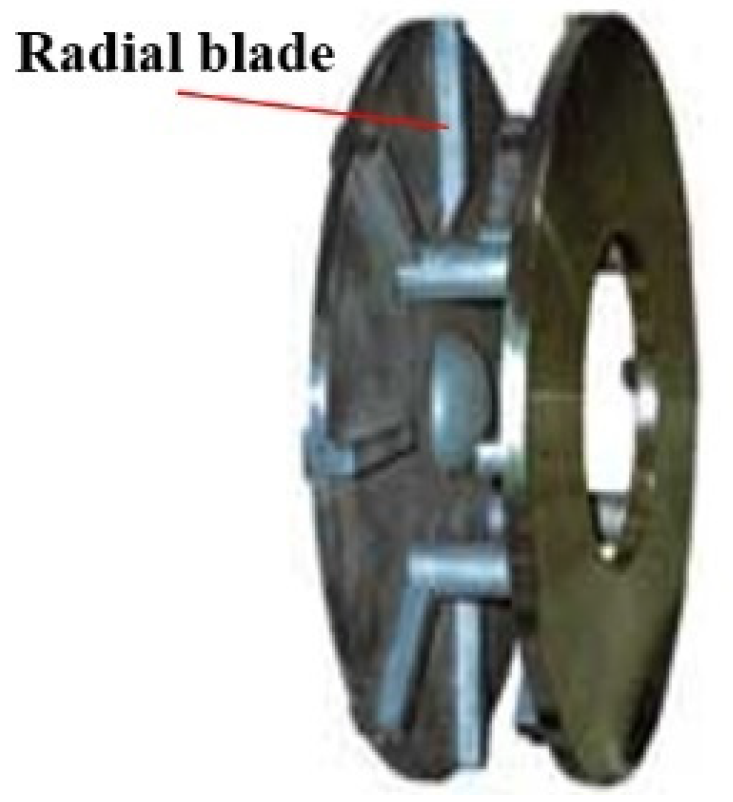
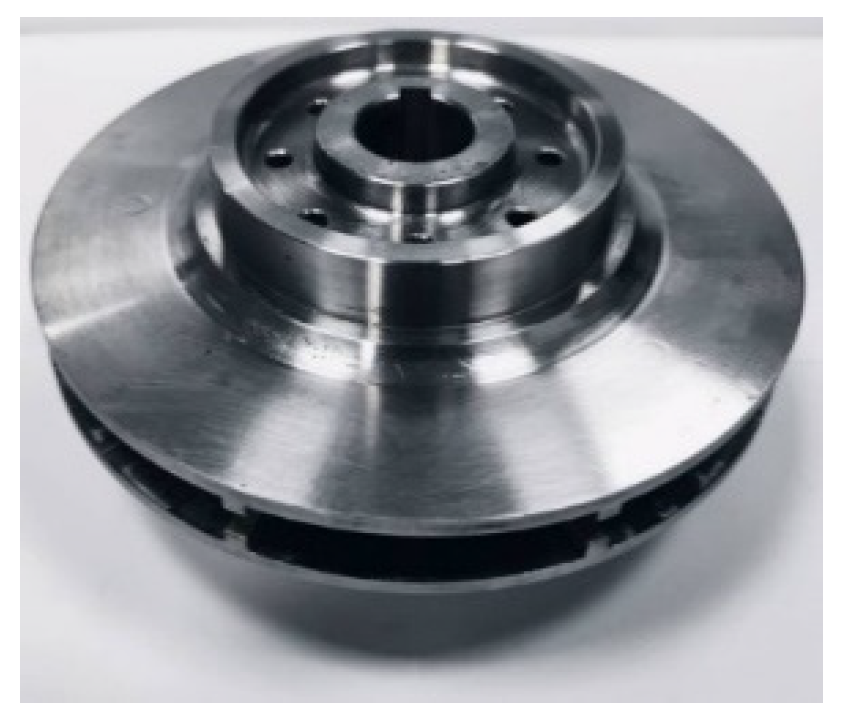
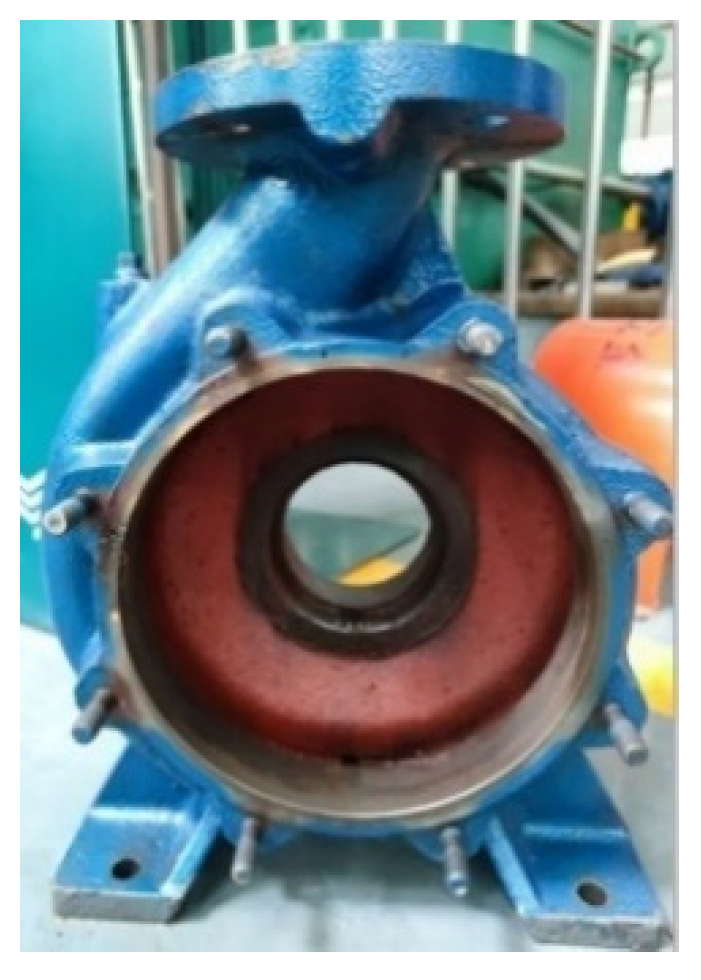
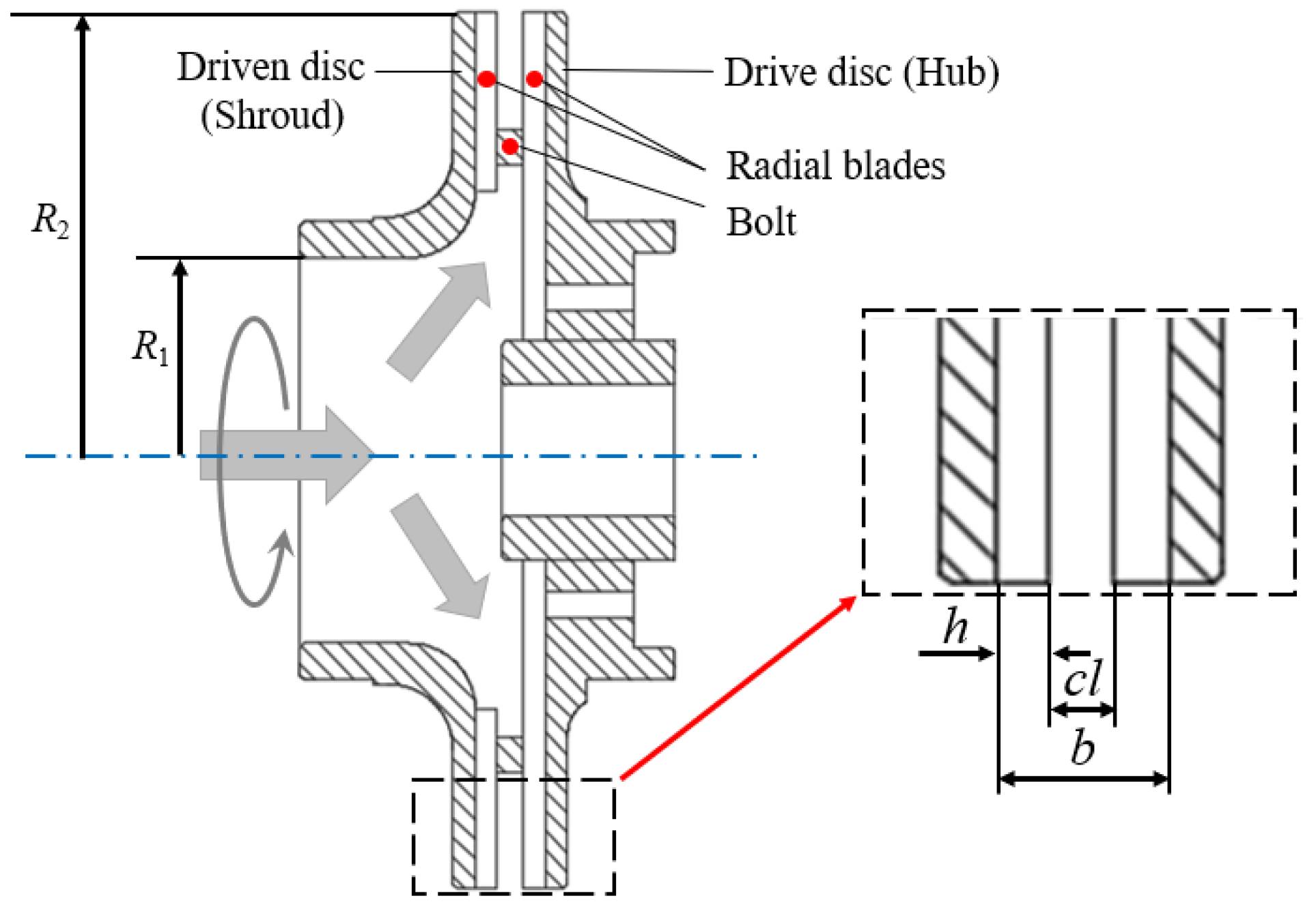
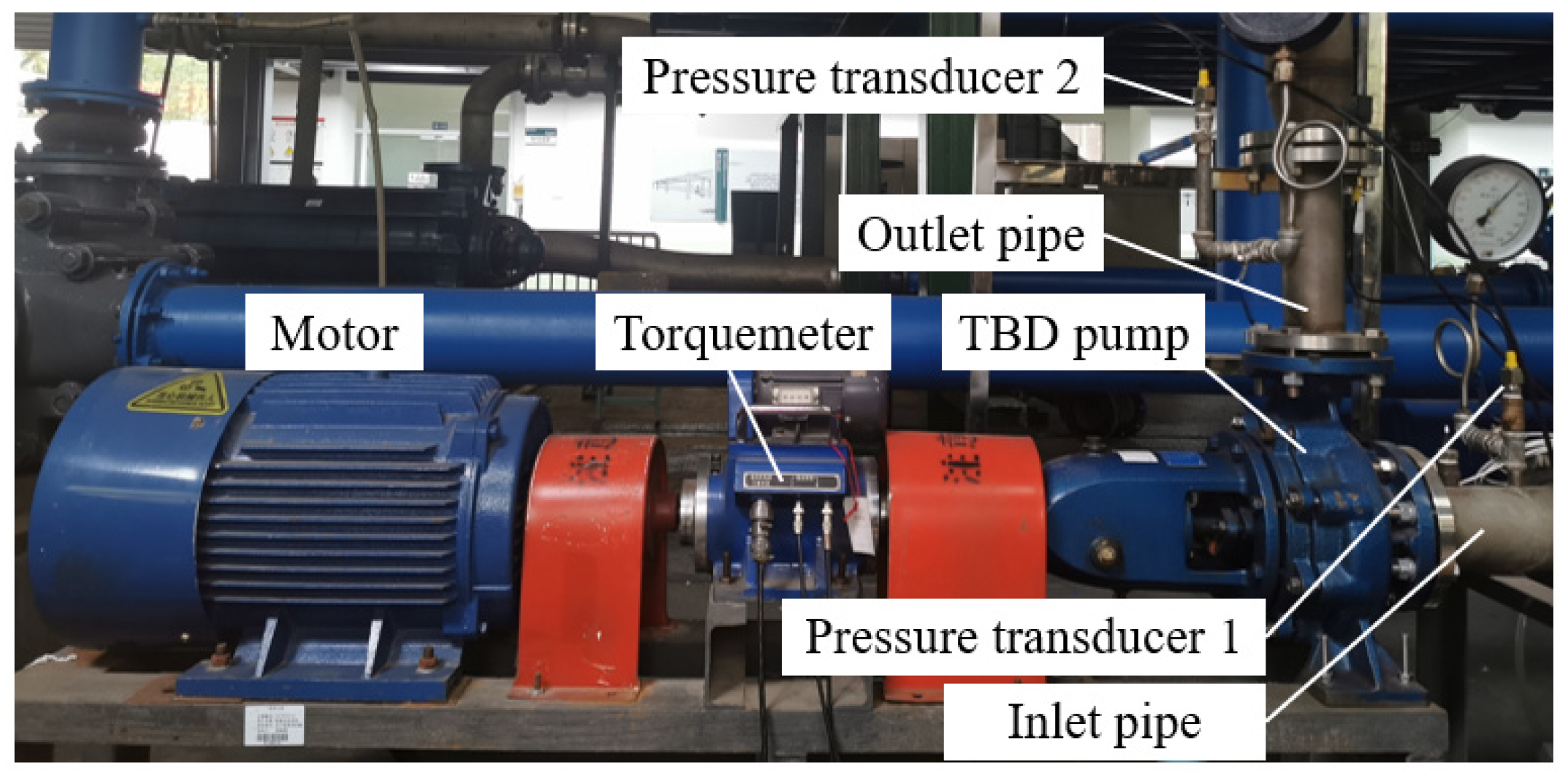

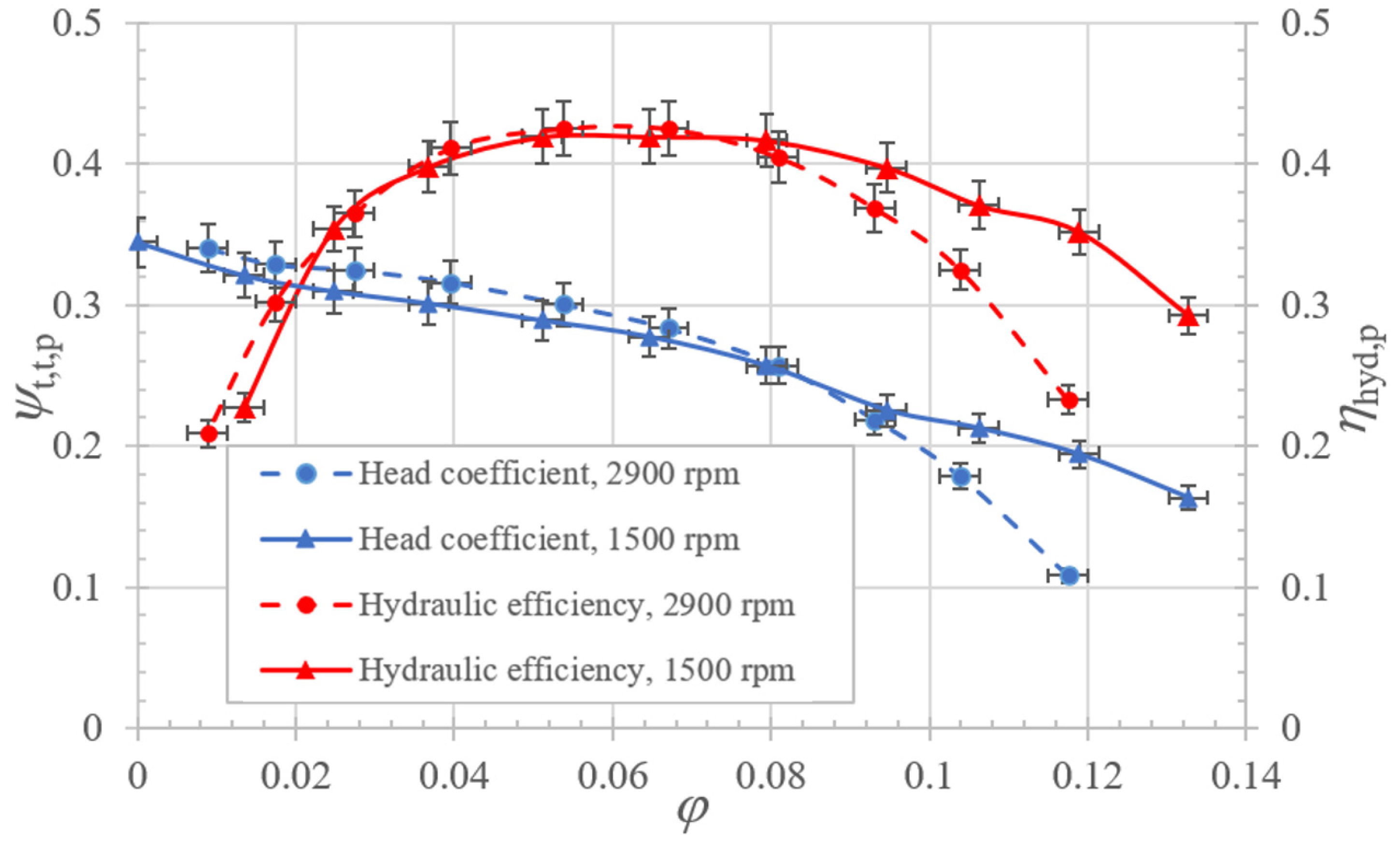
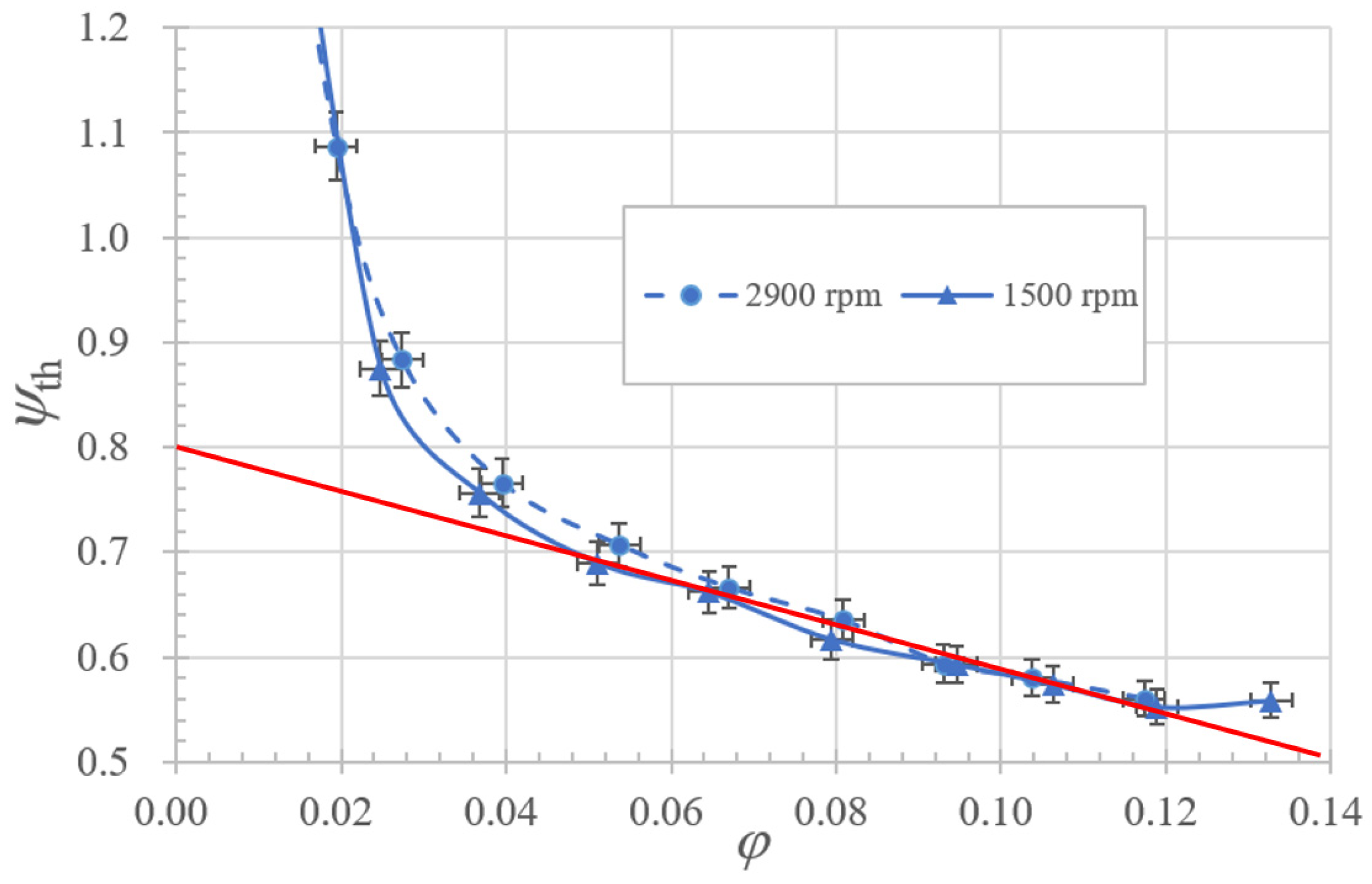
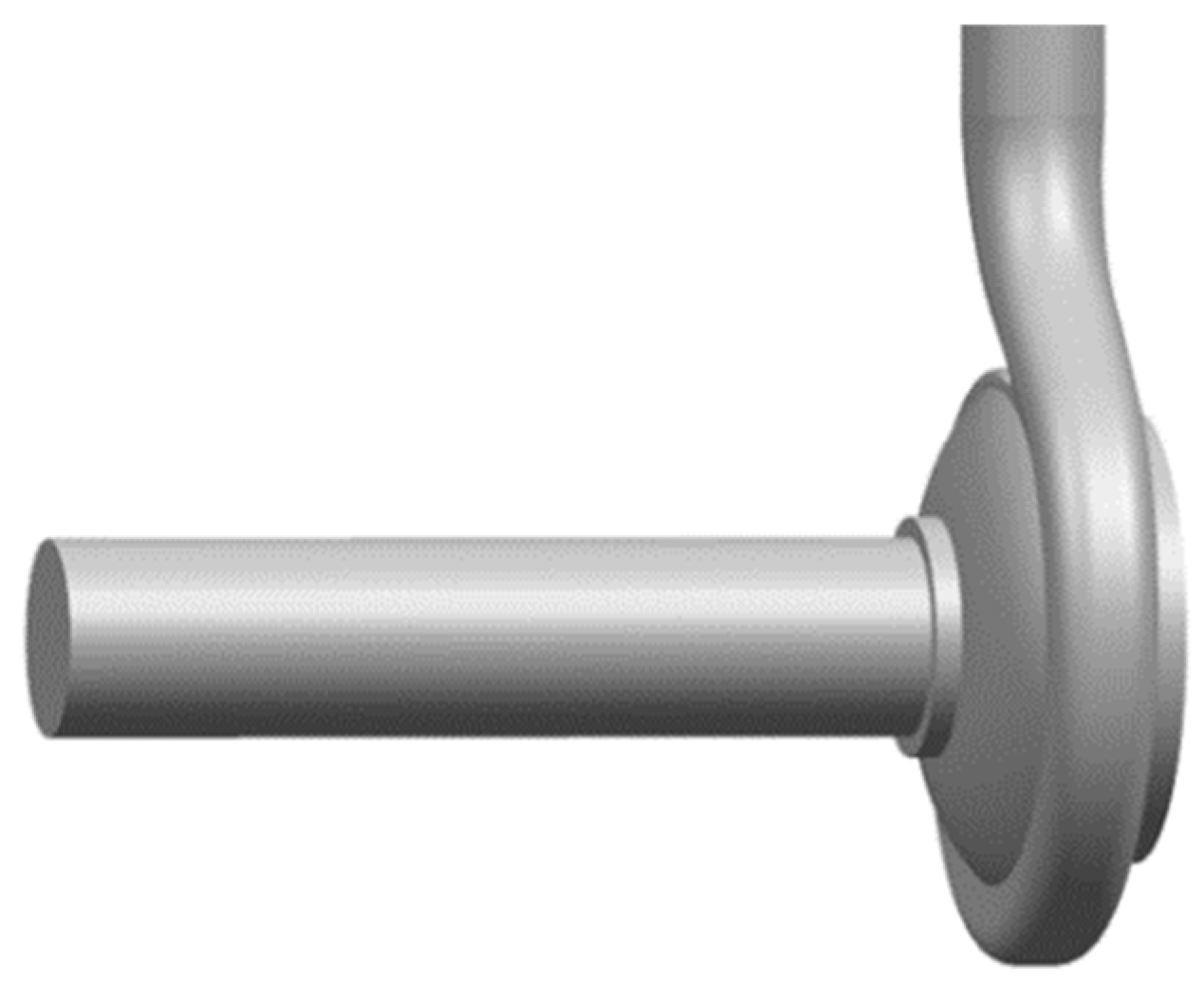
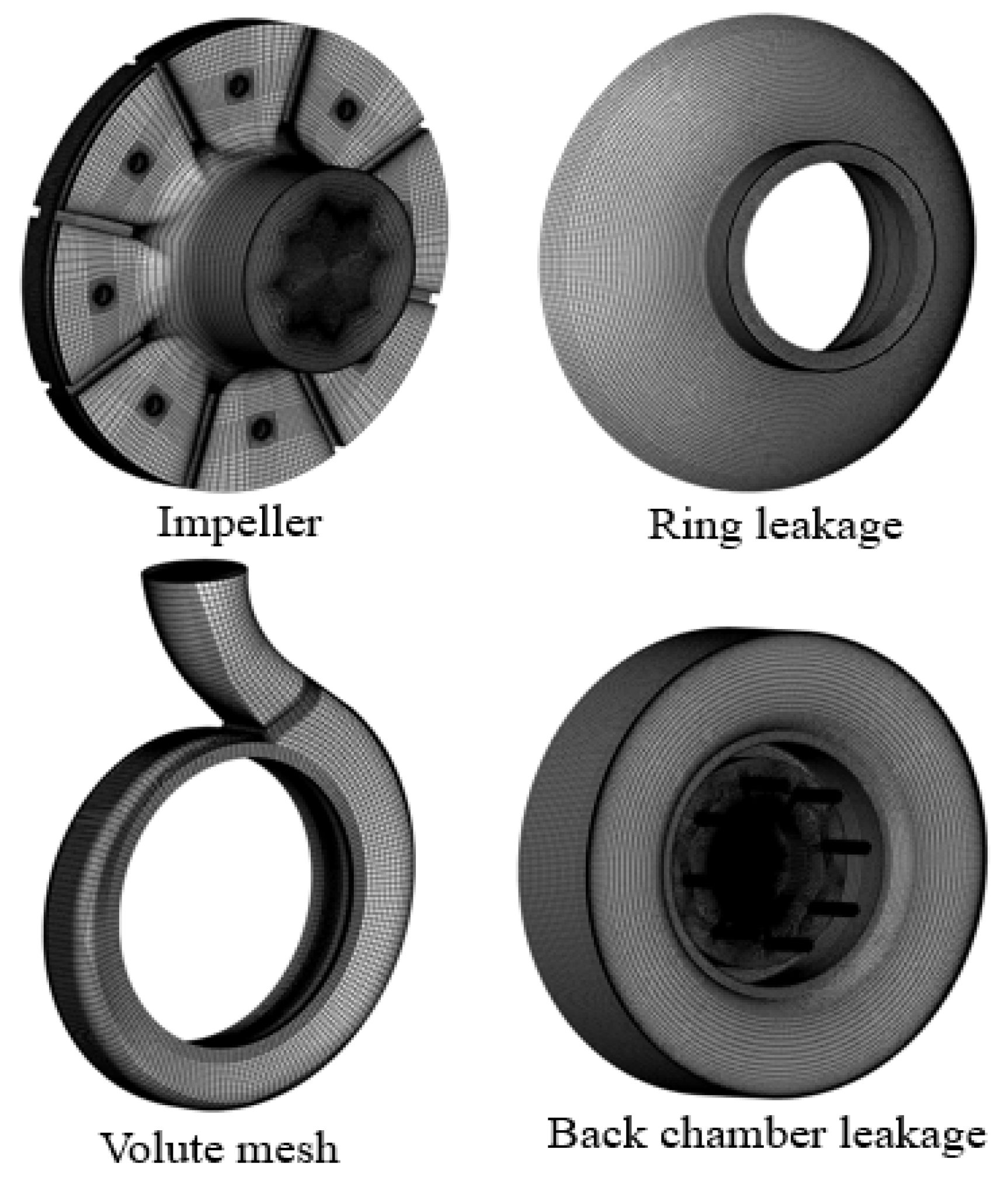
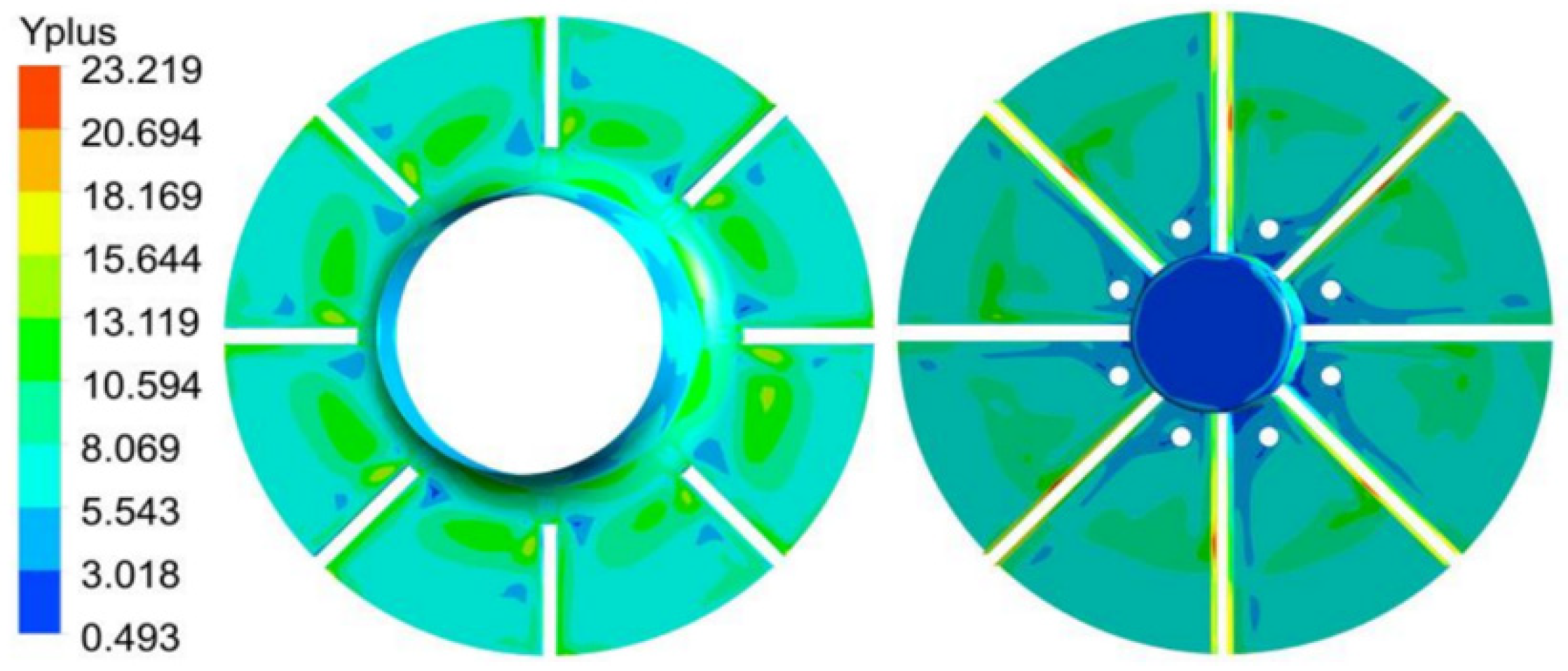
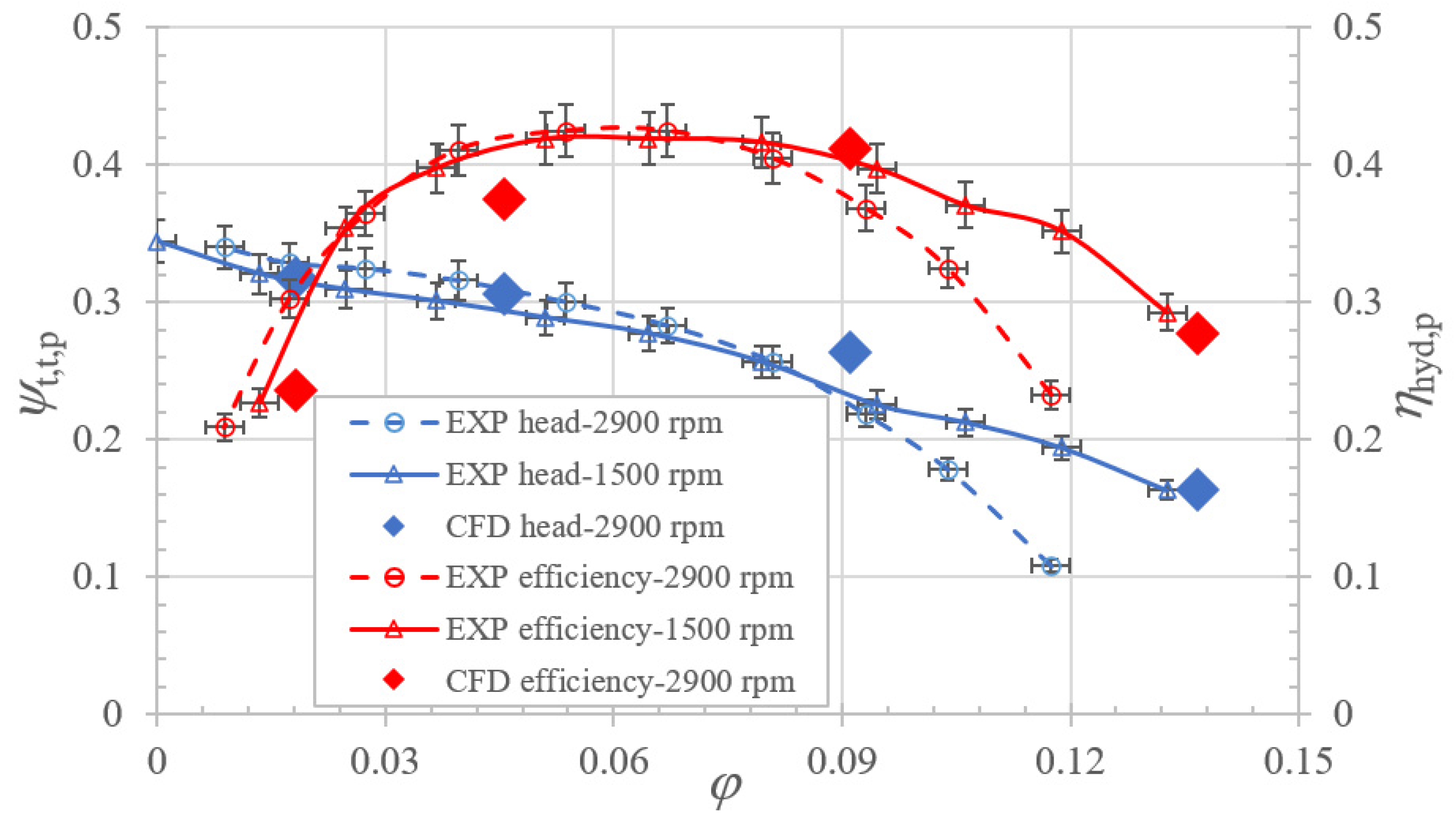

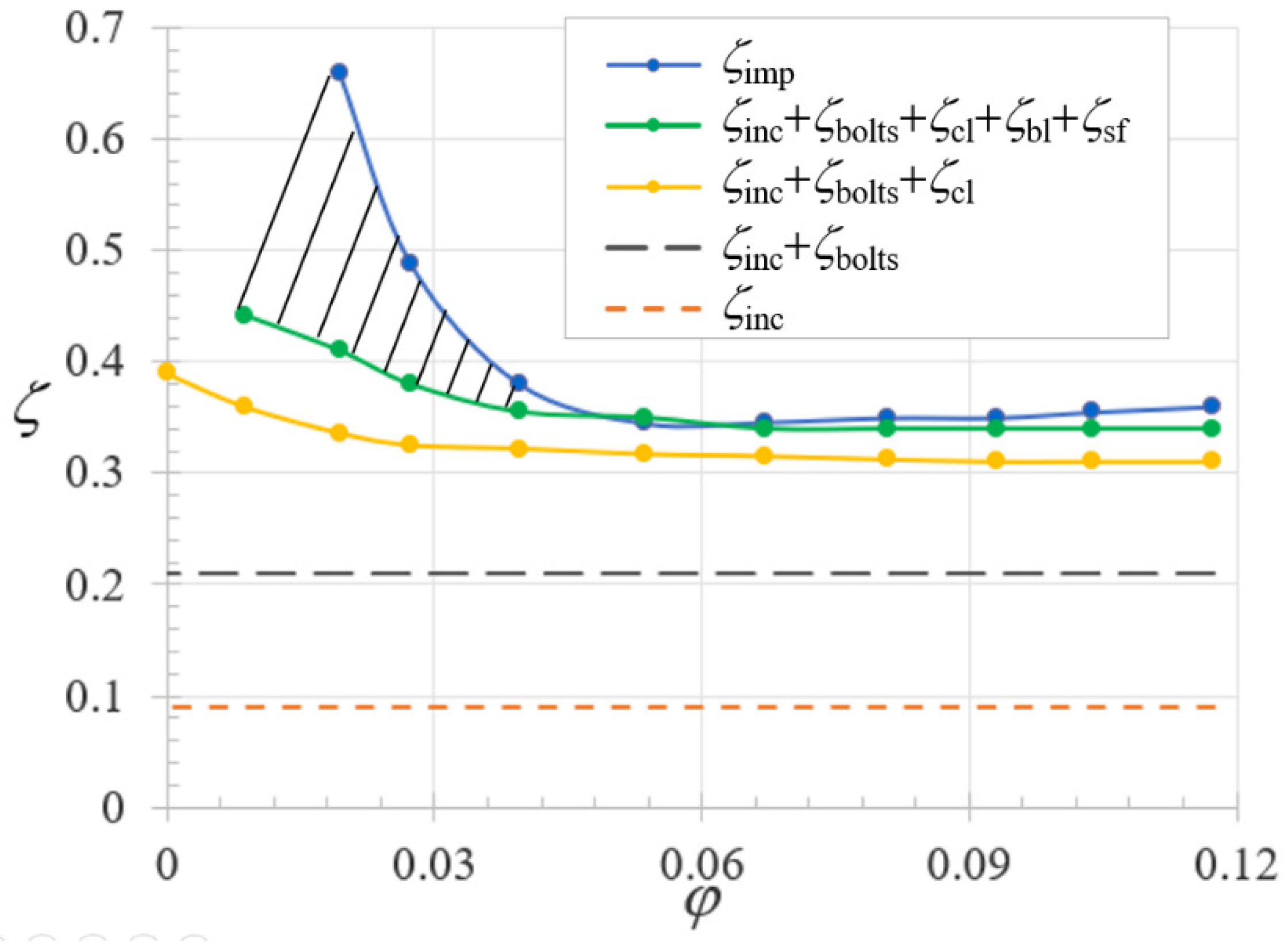
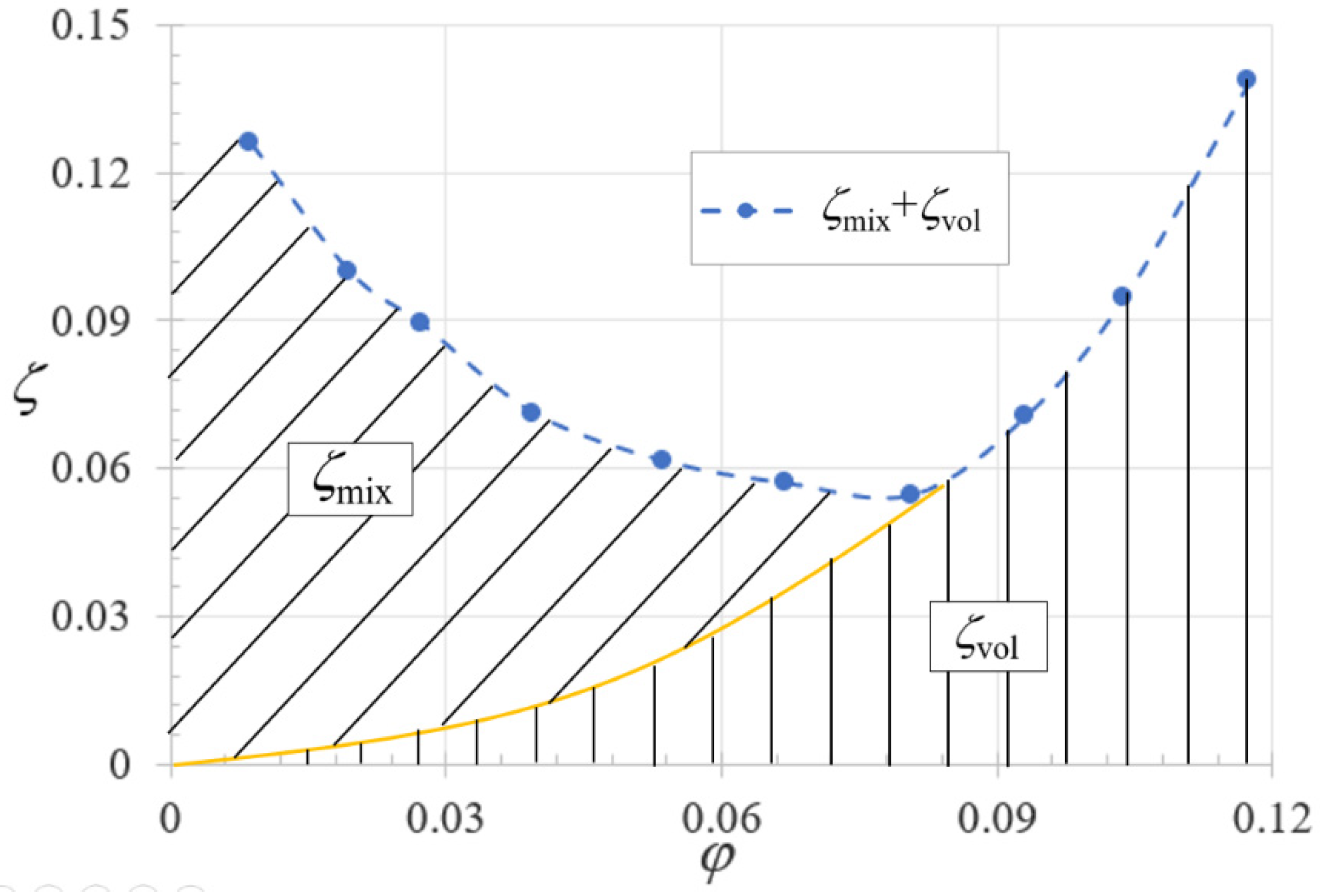
| Geometric Parameters | Values |
|---|---|
| Inlet shroud tip radius R1s | 60 mm |
| Inlet tube radius R1 | 50 mm |
| Outlet radius R2 | 100 mm |
| Number of blades ZB | 8 |
| Number of bolts | 8 |
| Bolt diameter | 12 mm |
| Radial bolt location | 75 mm |
| Inter blade clearance gap cl | 8 mm |
| Blade height h | 4 mm |
| Blade angle β′ | 90° (radial blade) |
| Impeller channel width b | 16 mm |
| Specific speed Ωs | 0.8 |
| Specific radius Λ | 2.4 |
| Mesh Number (Million) | Head | Efficiency | ||||
|---|---|---|---|---|---|---|
| Inlet and Outlet Pipes | Impeller | Volute and Leakages | Total | |||
| 1 | 0.11 | 0.35 | 0.43 | 0.89 | 30.89 | 25.31 |
| 2 | 0.33 | 0.64 | 1.20 | 2.17 | 30.05 | 23.88 |
| 3 | 0.58 | 1.40 | 2.59 | 4.57 | 29.95 | 23.82 |
| 4 | 0.79 | 2.81 | 4.43 | 8.03 | 29.77 | 23.63 |
Publisher’s Note: MDPI stays neutral with regard to jurisdictional claims in published maps and institutional affiliations. |
© 2022 by the authors. Licensee MDPI, Basel, Switzerland. This article is an open access article distributed under the terms and conditions of the Creative Commons Attribution (CC BY) license (https://creativecommons.org/licenses/by/4.0/).
Share and Cite
Heng, Y.; He, K.; Jiang, Q.; Zhang, W.; Bois, G.; Liu, X. An Analysis on Hydraulic Loss in a Co-Rotating Bladed Disc Pump. J. Mar. Sci. Eng. 2022, 10, 214. https://doi.org/10.3390/jmse10020214
Heng Y, He K, Jiang Q, Zhang W, Bois G, Liu X. An Analysis on Hydraulic Loss in a Co-Rotating Bladed Disc Pump. Journal of Marine Science and Engineering. 2022; 10(2):214. https://doi.org/10.3390/jmse10020214
Chicago/Turabian StyleHeng, Yaguang, Kunjian He, Qifeng Jiang, Weibin Zhang, Gérard Bois, and Xiaobing Liu. 2022. "An Analysis on Hydraulic Loss in a Co-Rotating Bladed Disc Pump" Journal of Marine Science and Engineering 10, no. 2: 214. https://doi.org/10.3390/jmse10020214
APA StyleHeng, Y., He, K., Jiang, Q., Zhang, W., Bois, G., & Liu, X. (2022). An Analysis on Hydraulic Loss in a Co-Rotating Bladed Disc Pump. Journal of Marine Science and Engineering, 10(2), 214. https://doi.org/10.3390/jmse10020214






